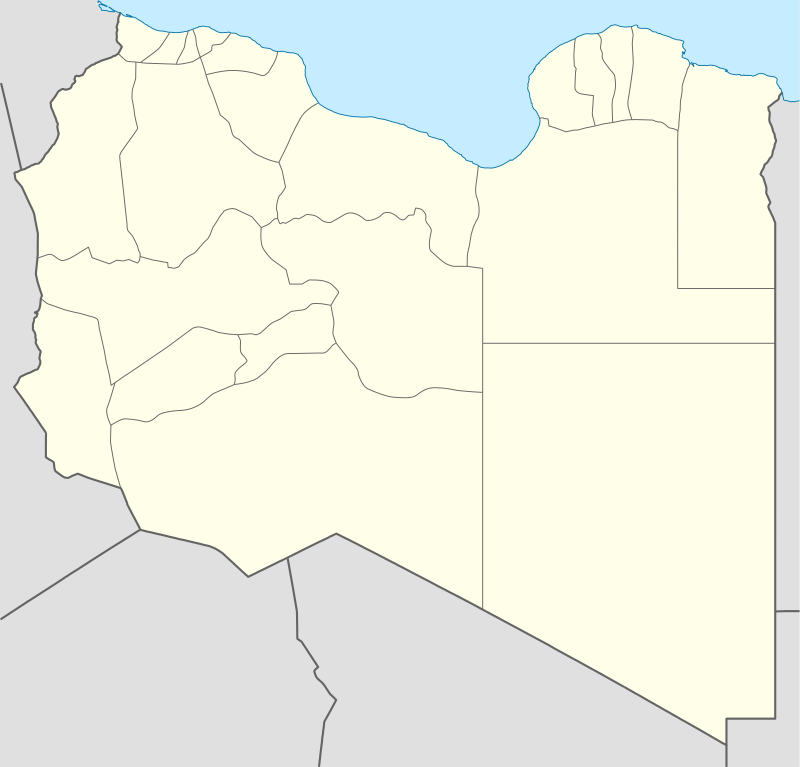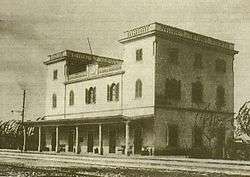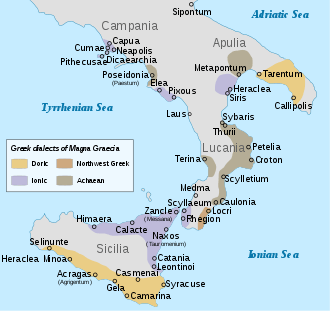Barca (ancient city)
Barca (Arabic: برقة, Barqa; Berber: Berqa), also called Barce (Greek: Βάρκη, Bárkē), was an ancient city and former bishopric, which survives as both a Latin Catholic and an Orthodox titular see.
Arabic: برقة | |
 Shown within Libya | |
| Alternative name | Latin: Antaeopolis[1] |
|---|---|
| Location | Libya |
| Region | Marj District |
| Coordinates | 32.498333°N 20.892778°E |
History
Antiquity
.jpg)
Barca was an Ancient Libyan settlement that became an ancient Greek colony and later a Roman and a Byzantine city in North Africa. It was in the coastal area of what is today Libya. As a Greek city, it was part of the Cyrenaican Pentapolis along with the city of Cyrene itself. Achaemenid king Darius I established Barcaean captives in a village in Bactria, which was still flourishing in Herodotus' time.[2]
According to most archeologists, it was situated at Marj, but according to Alexander Graham it was at Tolmeita (Ptolemais).[3] No remains of the ancient settlement are visible at Marj, but some of the finds made there during the Italian colonial dominance of Libya (1913–41) are on display in the museum at Tolmeita.
The city's name, Arabized as Barqah, came to refer to the former state and province of Cyrenaica.[4]
Since the Arab conquest

Barce was part of the Exarchate of Africa until it was conquered by the Arabs in 643–644 during the Islamic conquest of North Africa. It originally served as the capital of the Barqah province of the Caliphate. When the Ottoman Turks conquered the region in 1521, they used the Turkish form "Barka" for the province, but did not retain the city's status as its capital.
Barca and Christianity
Early Christianity spread to the Pentapolis of North Africa from Egypt. Synesius of Cyrene (370–414 AD), Bishop of Ptolemais, received his instruction at Alexandria in both the Catechetical School and the Museion, and he retained a great deal of reverence and affection for Hypatia, the last pagan Neoplatonist, whose classes he had attended. Synesius was raised to the episcopate by Theophilus, patriarch of Alexandria, in 410.
In accordance with a ruling of the Council of Nicaea in 325, Cyrenaica is recognized as ecclesiastically dependent on the See of Alexandria. Pentapolis is therefore included in the titles used both by the patriarch of the Coptic Church[5] and by the Greek Orthodox Patriarch of Alexandria.[6]
Although it was often destroyed and then restored during the Roman period, becoming a mere borough, Barca was, nevertheless, the seat of a bishopric. The bishops who participated in the First Council of Nicaea in 325 included the Arian Zopyros of Barca.[7] Zenobius signed the acts of the Council of Ephesus in 431[8] and Theodorus took part in the Robber Council of Ephesus in 449,[9] whose decisions were overthrown by the Council of Chalcedon in 451.[10][11][12][13]
Orthodox titular see
The Metropolitan of Western Pentapolis held the most senior position in the Holy Synod of the Coptic Orthodox Church after that of the Pope of Alexandria. Since the demise of that eparchy as a major Archiepiscopal Metropolis in the days of Pope John VI of Alexandria, the position is held as a titular see attached to another Diocese.
Latin catholic titular see
Also for the Catholic Church, Barca, no longer a residential bishopric, is today listed as a titular see.[14] Over the past century there have been 11 bishops of the Catholic titular See. The most recent has been Andraos Salama prior to his appointment as bishop of the Coptic Catholic Eparchy of Giza.[15]
See also
- Apollonia
- Ptolemais
References
- Matthew S. Gordon; Chase F. Robinson; Everett K. Rowson; Michael Fishbein, eds. (2017). The Works of Ibn Wāḍiḥ al-Yaʿqūbī (Volume 1): An English Translation. Brill. p. 182. ISBN 9789004364141.
- http://www.iranicaonline.org/articles/deportations#pt1
- Graham, Alexander (1902) Roman Africa: an outline of the history of the Roman occupation of North Africa, based chiefly upon inscriptions and monumental remains in that country Longmans, Green, and Co., London, p. 312, OCLC 2735641
- "Barce" Encyclopædia Britannica (1964 edition) p. 153
- Atiya, Aziz S. "The Copts and Christian Civilization" Coptic.net, accessed 19 May 2009
- "The Patriarchate of Alexandria and All Africa". Archived from the original on 14 August 2014. Retrieved 12 August 2014.
- Mansi, Sacrorum conciliorum nova et amplissima collectio, t. II, coll. 693 e 698.
- Mansi, op. cit., t. IV, coll. 1221 e 1367.
- Mansi, op. cit., volVI, col. 926 e 933.
- Michel Lequien, Oriens christianus in quatuor Patriarchatus digestus, Paris 1740, Vol. II, coll. 625-626
- Pius Bonifacius Gams, Series episcoporum Ecclesiae Catholicae, (Leipzig, 1931), p. 462
- Raymond Janin, v. Barca in Dictionnaire d'Histoire et de Géographie ecclésiastiques, vol. VI, 1932, coll. 669-670
- Louis Petit, "Barca" in Catholic Encyclopedia (New York 1907) Archived 19 August 2014 at the Wayback Machine
- Annuario Pontificio 2013 (Libreria Editrice Vaticana 2013 ISBN 978-88-209-9070-1), p. 846
- David Cheney, Diocese of Barca, at Catholic-Hierarchy.org.
Sources and references
| Wikisource has the text of the 1911 Encyclopædia Britannica article Barca. |
- Herbermann, Charles, ed. (1913). . Catholic Encyclopedia. New York: Robert Appleton Company.
- Butler, The Arab Conquest of Egypt, p. 430
- Heinrich Gelzer, Patrum Nicaenorum nomina, p. 231
- Marquardt, Staatsverwaltung, I, p. 459
- Westermann, Großer Atlas zur Weltgeschichte (in German)
